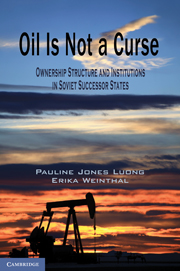Book contents
- Frontmatter
- Contents
- Tables
- Figures
- Maps
- 1 Rethinking the Resource Curse
- 2 Why Fiscal Regimes
- 3 State Ownership with Control versus Private Domestic Ownership
- 4 Two Versions of Rentierism
- 5 Petroleum Rents without Rentierism
- 6 State Ownership without Control versus Private Foreign Ownership
- 7 Eluding the Obsolescing Bargain
- 8 Revisiting the Obsolescing Bargain
- 9 Taking Domestic Politics Seriously
- 10 The Myth of the Resource Curse
- Appendix A List of Authors’ Interviews
- Appendix B Variation in Ownership Structure in Developing Countries
- Appendix C Responses to Select Life in Transition Survey (LiTS) Questions by Age Group
- Appendix D Ranking Basis for Determining which Countries are Included in Our Database
- Works Cited
- Index
5 - Petroleum Rents without Rentierism
Domestic Private Ownership in the Russian Federation
Published online by Cambridge University Press: 05 June 2012
- Frontmatter
- Contents
- Tables
- Figures
- Maps
- 1 Rethinking the Resource Curse
- 2 Why Fiscal Regimes
- 3 State Ownership with Control versus Private Domestic Ownership
- 4 Two Versions of Rentierism
- 5 Petroleum Rents without Rentierism
- 6 State Ownership without Control versus Private Foreign Ownership
- 7 Eluding the Obsolescing Bargain
- 8 Revisiting the Obsolescing Bargain
- 9 Taking Domestic Politics Seriously
- 10 The Myth of the Resource Curse
- Appendix A List of Authors’ Interviews
- Appendix B Variation in Ownership Structure in Developing Countries
- Appendix C Responses to Select Life in Transition Survey (LiTS) Questions by Age Group
- Appendix D Ranking Basis for Determining which Countries are Included in Our Database
- Works Cited
- Index
Summary
If the [Russian] state does not learn to collect taxes, it will cease to exist.
– Sergei Kiriyenko, Prime Minister, June 23, 1998Competitiveness of the economy … rests on stability and predictability, clearness and transparency of rules and procedures. Otherwise, we can hardly ever succeed. Capital is invested in areas where it is guaranteed best possible conditions, and love to Russia alone is not a sufficient motivator.
– Sergey Dimitrievich Shatalov, First Deputy Minister of Finance, July 5, 2002The most important feature of the new Tax Code is its stability. Even if you don’t like paying taxes, there are now rules that do not change. Even if it is not perfect, it is clear and predictable. This is good for business … . It is good for the major oil companies. And what is good for the major oil companies is good for Russia. Just like Ford [Motor Co.] in America … .
– Representative of Lukoil, June 25, 2002Whereas Turkmenistan and Uzbekistan adopted one of the most common ownership structures among petroleum-rich states – state ownership with control (S1) – from the early 1990s through the mid-2000s, the Russian Federation adopted one of the rarest over its oil sector – private domestic ownership (P1). According to our research, over the course of the twentieth century, only a handful of developing countries – Brazil (1891–1937), Venezuela (1904–1906), Romania (1924–1944), and Guatemala (1949–1982) – have opted to privatize their petroleum sector to domestic actors. Russia officially joined this small group in 1993 when it created three vertically integrated joint-stock oil companies – Lukoil, Surgutneftegaz, and Yukos – to replace the state-owned Soviet oil monopoly. As a result, we predict that it is also more likely to enjoy a rare outcome across mineral-rich states: a strong fiscal regime – that is, one that encompasses a tax system that is stable, broad-based, and relies primarily on direct and explicit taxation and a system of expenditures that emphasizes budgetary stability and transparency. In this chapter, we demonstrate not only that Russia did indeed adopt a strong fiscal regime from 1999–2005 – contrary to what both scholars of Russia and the resource curse predicted – but also that this outcome was facilitated by its choice of ownership structure.
As we argue in Chapter 3, P1 fosters strong fiscal regimes because – in contrast to S1 – it provides both the direct claimants (here, domestic private owners) and indirect claimants (here, governing elites and the population) with an incentive to supply and demand institutions that set effective limits on the state’s ability to extract and spend the proceeds from mineral wealth – incentives that are reinforced by the process through which these institutions emerge. More specifically, P1 generates high transaction costs (TCs), societal expectations for limited redistribution, and interdependent power relations. The combination of high TCs and low societal expectations promotes a mutual desire for fiscal stability, more visible forms of taxation across sectors, and limited public spending, while interdependent power relations in the context of low TCs and high societal expectations serve to reinforce these incentives via an explicit bargaining process.
- Type
- Chapter
- Information
- Oil Is Not a CurseOwnership Structure and Institutions in Soviet Successor States, pp. 121 - 180Publisher: Cambridge University PressPrint publication year: 2010

